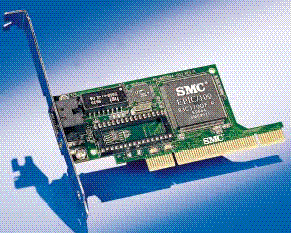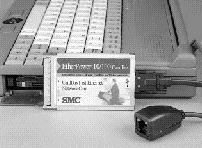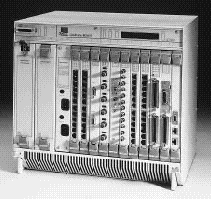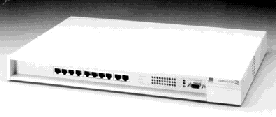
The products featured on these pages are illustrative of the types of equipment which is available. Exact specs and details of current models are available from each of the manufacturers. This page does not attempt to compare or contrast the range of products offered by the various manufacturers. Such a comparison must consider the user needs, the existing equipment in use in the LAN, the features required and the overall cost.
Network Interface Cards come with a variety of connectors. The simplest cards allow only one type of cabling, but combination (combo) cards generally support a range of media types. The most commonly sold type of card is now the 10/100 Mbps interface card for twisted pair cabling.

A selection of Network Interface cards (NICs) from 3COM

EtherPower II 10/100 Mbps Ethernet adaptor for UTP from SMC
More sophisticated interface cards are also available for network workstations, file servers and other network computers. These cards usually allow higher throughput, and provide more buffering for storing frames received or to be transmitted. Some cards support additional layer 2 protocols to communicate with switches providing enhanced management and traffic control.
A number of suppliers offering Network Interface Card (NIC) for portable computer users. This type of NIC usually consists of a card (for a PCMCIA / CardBus slot) and a connector cable which connects the card to the network. The card shown supports 10/100 both 10 Mbps and 100 Mbps networks, and supports the IEEE Auto-Negotiation standard to automatically configure itself to run at the highest speed supported by the LAN segment. This dual-mode operation eases the migration from 10 Mbps Ethernet to 100 Mbps Ethernet providing true "plug and play".

3COM EtherLink III adaptor, combining high performance 10 Mbps Ethernet interface with high speed modem for combined office / remote access to the network.

CardBus Adaptor for 10 or 100 Mbps Ethernet from SMC.
Hardware of SMC CardBus Adaptor
The internal archecture of this card is shown below:

Repeaters and transceivers conforming to the IEEE 802.3 standards are available from a wide range of manufacturers.

Selection of 10 Mbps Ethernet repeaters and transceivers manufactured by 3COM (from the ISOLAN Range).
Most hubs in current use operate at 10 Mbps. Although some hubs are large devices with a large number of ports and additional management and security features, by far the majority of hubs in use have 6-12 ports and are small compact units designed for placing on an office desk.
![]()
8-port 3Com Office Connect Hub
To simplify network connections, hubs are often stacked on top of one another.

10 / 100 Mbps TigerStack Hubs from SMC. Using a hub, all ports must operate as one Ethernet LAN (or "collision domain") and all connected NICs must operate in the half-duplex (CSMA/CD) mode at the same transmission speed (either 10 or 100 Mbps)
Large modular hubs are also available for cabling large buildings and generally include extra features to ease management of the ports. Many modern modular hubs provide bridging / switching to allow connection between different LANs and different types of media.

The Linkbuilder MSH, a large modern modular hub manufactured by 3COM.
The emerging popularity of switching products can be viewed as a resurgence of bridge technology in a simpler, lower-cost, and higher-performance device with many more ports being supported. Most switches may operate at wire speed, providing much better performance than a traditional bridge. For example, a single 10 Mbps Ethernet interface can support a maximum theoretical transmission of 14,880 pps for 64-octet (minimum-size) frames. The switching logic inside the switch buffers the received frames, identifies the appropriate output port and retransmits the frame when this port becomes available. The decisions needed by the switch to identify the output port is based on the destination MAC address contained in each packet. Generally, this forwarding decision does not consider other information buried deep inside the packet. Unlike a bridge, a switch can forward data with very low latency, providing performance that is closer to single-LAN performance than bridged-LAN performance.
Ethernet Switches come in a variety of shapes and forms - ranging from the simplest low cost devices with a small number of ports to expensive high performance switches with a wealth of features to control and manage the data transmission in large networks.

A low cost stackable 10 Mbps Ethernet-only switch for economical work group performance enhancement manufactured by 3COM

A typical mid-range equipment available in 12- and 24-port versions. The LinkSwitch 1000 from 3COM provides wire-speed 10 Mbps on all switched Ethernet ports and a high-speed 100 Mbps Fast Ethernet "up link" connection towards the network core.

A typical small 100 Mbps switch, in this case the SuperStack II 3000 from 3COM with 8 100BTX ports. and one modular slot for a high speed (e.g. 100BFX fibre) up link.
At the centre (or core) of a large enterprise network, modular switches are often used. Such equipment is generally connected to less expensive switches or hubs which provide the connections to individual users. The modular switches provide high speed packet processing and a range of security / management functions. The modular design allows additional interface card to be added as the network expands or new types of network (e.g. Gigabit Ethernet) are added.

The Lanplex range of high performance modular switch from 3COM.
One of the more sophisticated range of switches is the Catalyst 5000 range offered by CISCO which provides a range of features designed to ease management of large networks and to provide integrated switching and routing - where the level 3 routers communicate with and control the layer 2 ethernet switches. This type of switch is to be found at the centre of the network of a large organisation.

Fully configured Catalyst 5000 switch displaying a wealth of communications processors, interface cards and with dual redundant power supplies.